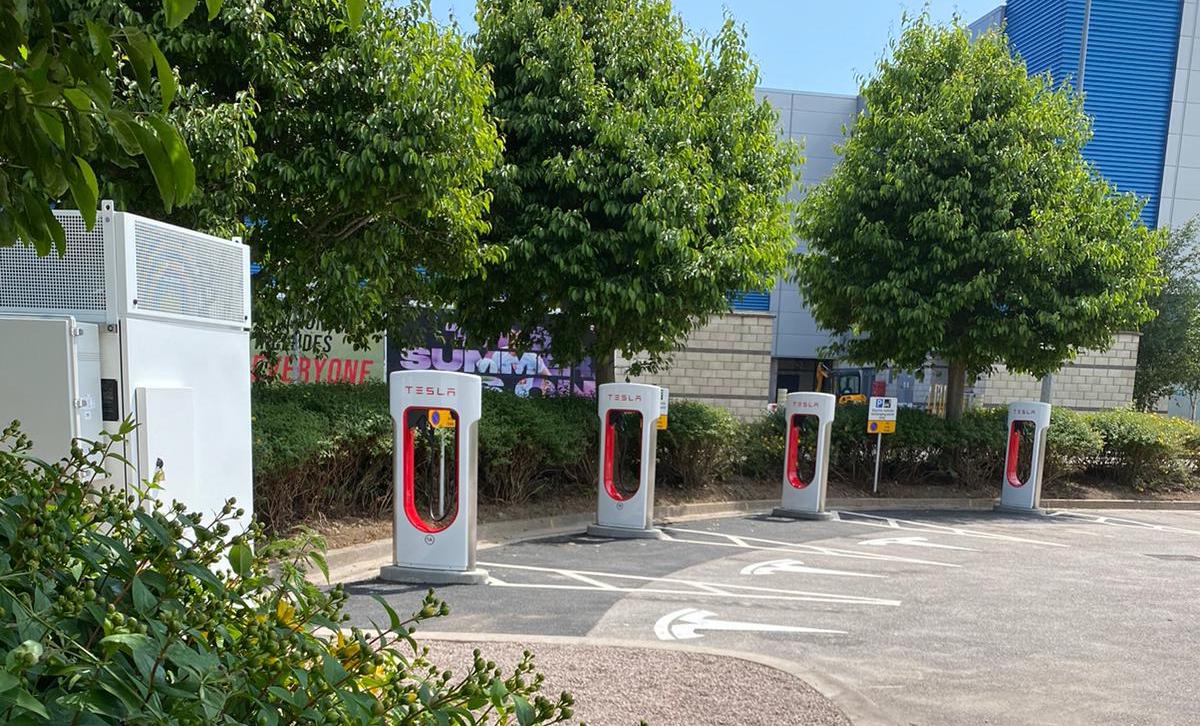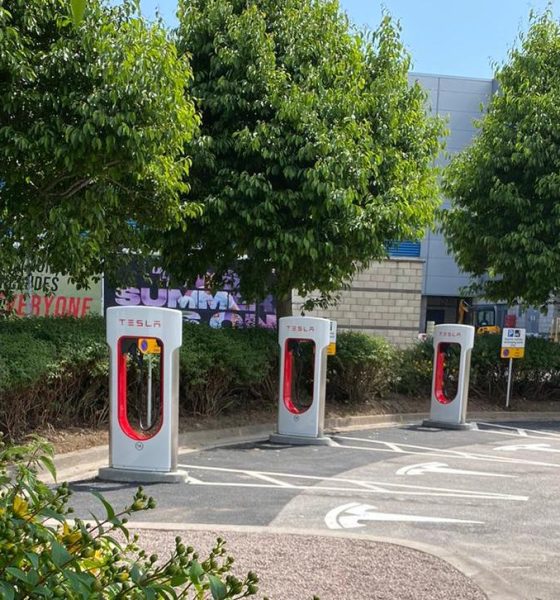Tesla has opened select Superchargers to non-Tesla electric vehicles (EVs) in Ireland, Romania and Hungary, as announced earlier this month.
A couple of weeks ago, the Tesla Charging account on X posted the news, saying that select Superchargers in each of the countries were opening to non-Tesla EVs. A report on Tuesday from The Irish Times noted that five of the nine Supercharging locations in the country will now be opened to non-Tesla EVs, including those in Dublin, Cork, Athenry, Enfield and Tralee.
Currently, Tesla’s Supercharger map only shows those in Athenry and Enfield as being open to all EVs, though the other stations are likely to follow as it sometimes takes the automaker a few weeks to update the map.
The report says that the included Superchargers in Ireland offer as many as 18 individual charging stalls, each with 250 kW charging speeds that can add up to 275 km or range in about 15 minutes.
Credit: Tesla | Supercharging Map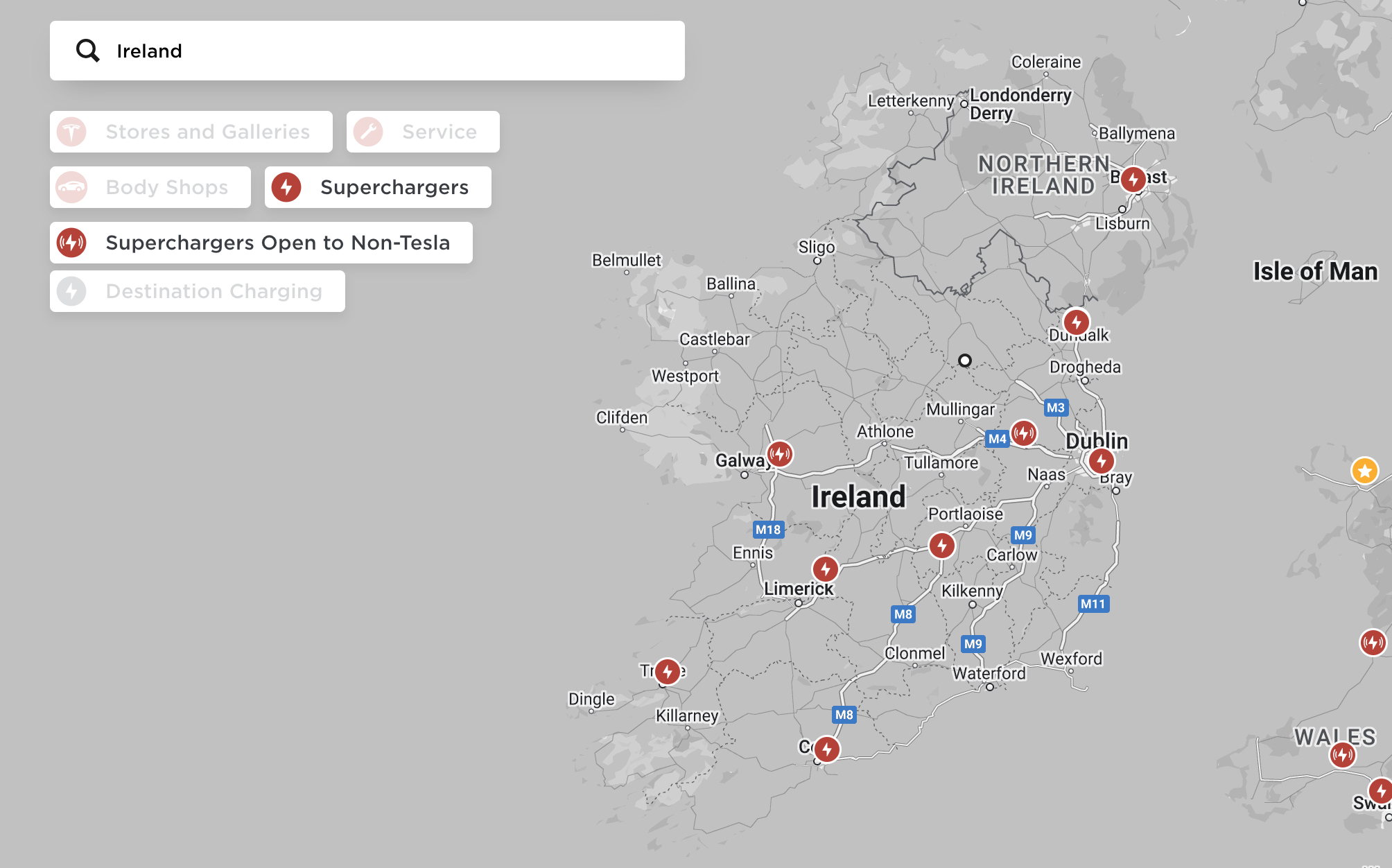
“Access to an extensive, convenient and reliable fast-charging network is critical for large-scale EV adoption,” a Tesla spokesperson told The Irish Times. “Since opening the first Superchargers in 2012 Tesla have been committed to rapid expansion of the network. Superchargers are designed and built by Tesla, charging up to 275km in 15 minutes rather than hours.
“Since the beginning of 2023, Tesla owners have Supercharged over 11 million kilometres in Ireland, offsetting 2.4 million kilograms of CO2.”
According to the Supercharger map, charging stations in Hungary open to non-Tesla EVs include four just outside of Budapest, one in Székesfehérvár, one in Miskolc, one in Debrecen and one in Szeged. Not far from these are the non-Tesla EV-compatible stations in Romania, which include sites in Timisoara, Cluj-Napoca, Sibiu, Pitesti, Constanța, Craiova and two in Bucharest.
Credit: Tesla | Supercharging Map Credit: Tesla | Supercharging Map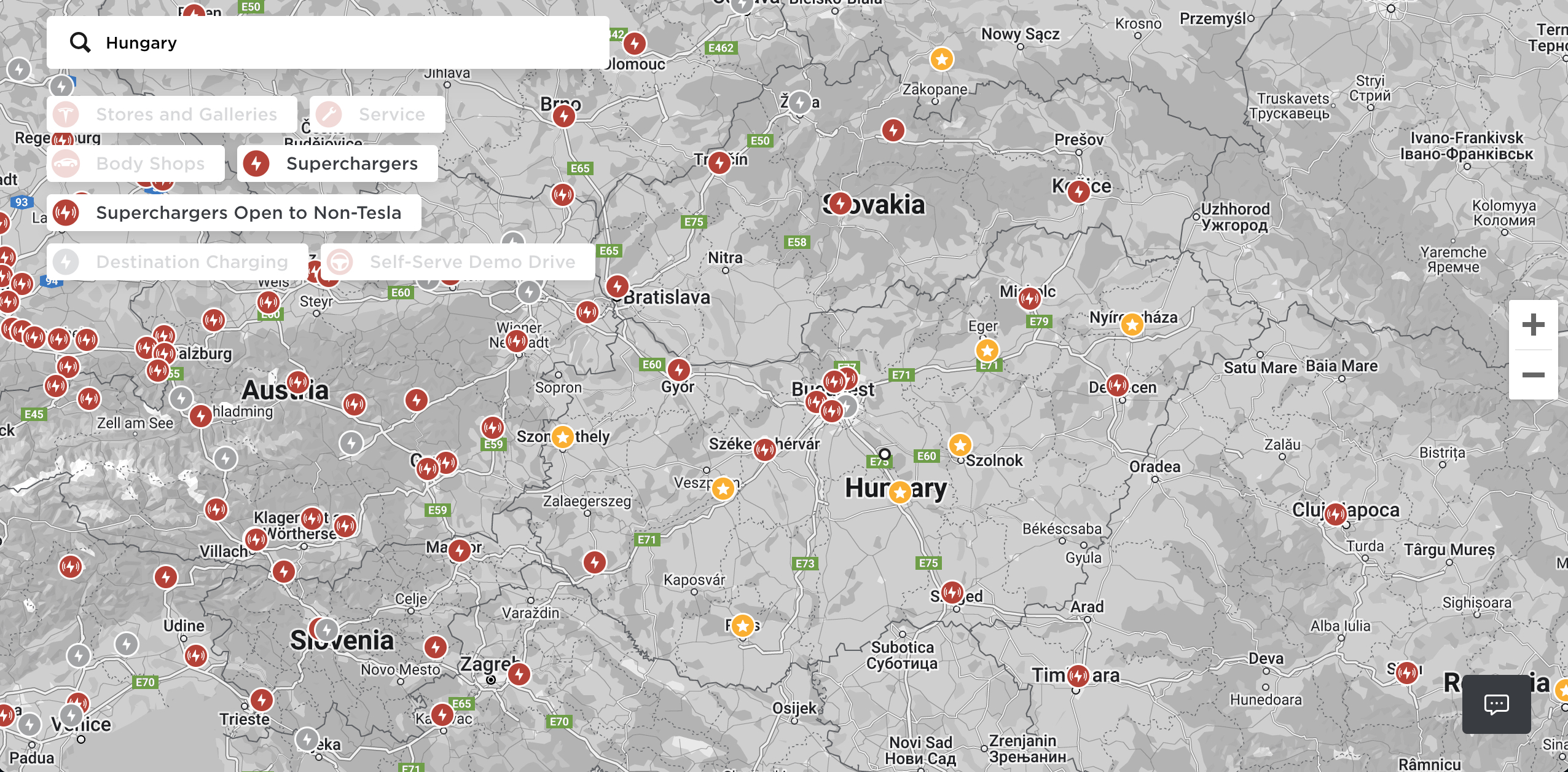
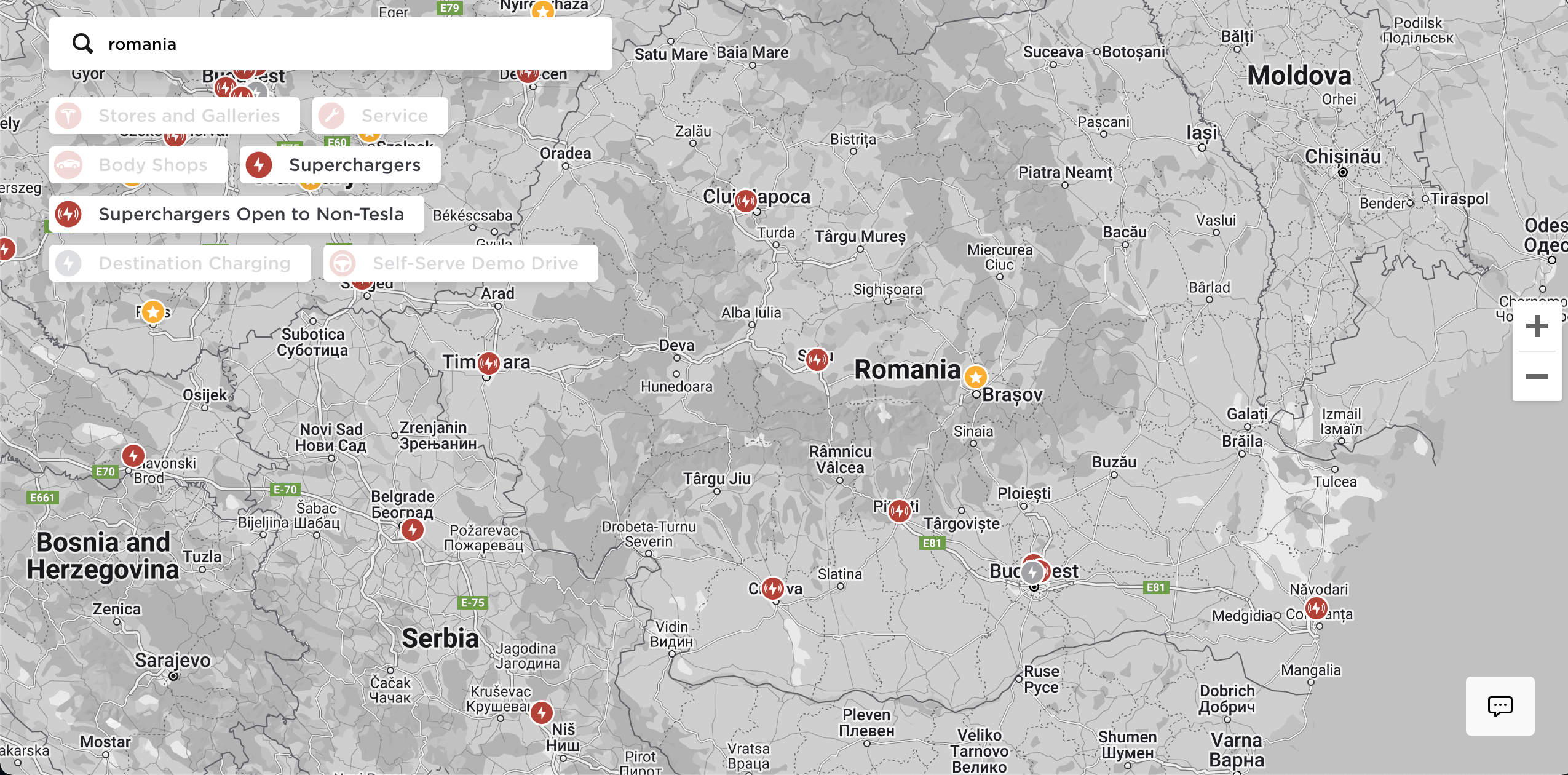
You can view Tesla’s full Supercharging map for yourself here, including a filtering option to see which Superchargers are open to non-Tesla EVs near you.
To use these Superchargers with a non-Tesla EV, drivers will simply need to download the Tesla app and sign up for an account. While charging prices vary from one station to the next and depending on when users charge, users can also purchase a Supercharging membership for €12.99 per month, offering even lower prices than normal.
Tesla has been piloting programs to have its Superchargers open to non-Tesla EVs in select sites across Europe and around the world over the past couple of years. Looking at the Supercharger map in Europe shows that several locations on the continent now offer charging to all EVs, while the automaker has been slowly rolling this out to select locations in the U.S.
In addition, Tesla is preparing to open Superchargers in North America to customers of Ford, General Motors (GM) and several other automakers in the coming months and years, after its charging hardware, dubbed the North American Charging Standard (NACS), was adopted by most other EV makers throughout 2023.
What are your thoughts? Let me know at zach@teslarati.com, find me on X at @zacharyvisconti, or send your tips to us at tips@teslarati.com.

News
Tesla FSD fleet is nearing 7 billion total miles, including 2.5 billion city miles
As can be seen on Tesla’s official FSD webpage, vehicles equipped with the system have now navigated over 6.99 billion miles.

Tesla’s Full Self-Driving (Supervised) fleet is closing in on almost 7 billion total miles driven, as per data posted by the company on its official FSD webpage.
These figures hint at the massive scale of data fueling Tesla’s rapid FSD improvements, which have been quite notable as of late.
FSD mileage milestones
As can be seen on Tesla’s official FSD webpage, vehicles equipped with the system have now navigated over 6.99 billion miles. Tesla owner and avid FSD tester Whole Mars Catalog also shared a screenshot indicating that from the nearly 7 billion miles traveled by the FSD fleet, more than 2.5 billion miles were driven inside cities.
City miles are particularly valuable for complex urban scenarios like unprotected turns, pedestrian interactions, and traffic lights. This is also the difference-maker for FSD, as only complex solutions, such as Waymo’s self-driving taxis, operate similarly on inner-city streets. And even then, incidents such as the San Francisco blackouts have proven challenging for sensor-rich vehicles like Waymos.
Tesla’s data edge
Tesla has a number of advantages in the autonomous vehicle sector, one of which is the size of its fleet and the number of vehicles training FSD on real-world roads. Tesla’s nearly 7 billion FSD miles then allow the company to roll out updates that make its vehicles behave like they are being driven by experienced drivers, even if they are operating on their own.
So notable are Tesla’s improvements to FSD that NVIDIA Director of Robotics Jim Fan, after experiencing FSD v14, noted that the system is the first AI that passes what he described as a “Physical Turing Test.”
“Despite knowing exactly how robot learning works, I still find it magical watching the steering wheel turn by itself. First it feels surreal, next it becomes routine. Then, like the smartphone, taking it away actively hurts. This is how humanity gets rewired and glued to god-like technologies,” Fan wrote in a post on X.
News
Tesla starts showing how FSD will change lives in Europe
Local officials tested the system on narrow country roads and were impressed by FSD’s smooth, human-like driving, with some calling the service a game-changer for everyday life in areas that are far from urban centers.

Tesla has launched Europe’s first public shuttle service using Full Self-Driving (Supervised) in the rural Eifelkreis Bitburg-Prüm region of Germany, demonstrating how the technology can restore independence and mobility for people who struggle with limited transport options.
Local officials tested the system on narrow country roads and were impressed by FSD’s smooth, human-like driving, with some calling the service a game-changer for everyday life in areas that are far from urban centers.
Officials see real impact on rural residents
Arzfeld Mayor Johannes Kuhl and District Administrator Andreas Kruppert personally tested the Tesla shuttle service. This allowed them to see just how well FSD navigated winding lanes and rural roads confidently. Kruppert said, “Autonomous driving sounds like science fiction to many, but we simply see here that it works totally well in rural regions too.” Kuhl, for his part, also noted that FSD “feels like a very experienced driver.”
The pilot complements the area’s “Citizen Bus” program, which provides on-demand rides for elderly residents who can no longer drive themselves. Tesla Europe shared a video of a demonstration of the service, highlighting how FSD gives people their freedom back, even in places where public transport is not as prevalent.
What the Ministry for Economic Affairs and Transport says
Rhineland-Palatinate’s Minister Daniela Schmitt supported the project, praising the collaboration that made this “first of its kind in Europe” possible. As per the ministry, the rural rollout for the service shows FSD’s potential beyond major cities, and it delivers tangible benefits like grocery runs, doctor visits, and social connections for isolated residents.
“Reliable and flexible mobility is especially vital in rural areas. With the launch of a shuttle service using self-driving vehicles (FSD supervised) by Tesla in the Eifelkreis Bitburg-Prüm, an innovative pilot project is now getting underway that complements local community bus services. It is the first project of its kind in Europe.
“The result is a real gain for rural mobility: greater accessibility, more flexibility and tangible benefits for everyday life. A strong signal for innovation, cooperation and future-oriented mobility beyond urban centers,” the ministry wrote in a LinkedIn post.
News
Tesla China quietly posts Robotaxi-related job listing
Tesla China is currently seeking a Low Voltage Electrical Engineer to work on circuit board design for the company’s autonomous vehicles.

Tesla has posted a new job listing in Shanghai explicitly tied to its Robotaxi program, fueling speculation that the company is preparing to launch its dedicated autonomous ride-hailing service in China.
As noted in the listing, Tesla China is currently seeking a Low Voltage Electrical Engineer to work on circuit board design for the company’s autonomous vehicles.
Robotaxi-specific role
The listing, which was shared on social media platform X by industry watcher @tslaming, suggested that Tesla China is looking to fill the role urgently. The job listing itself specifically mentions that the person hired for the role will be working on the Low Voltage Hardware team, which would design the circuit boards that would serve as the nervous system of the Robotaxi.
Key tasks for the role, as indicated in the job listing, include collaboration with PCB layout, firmware, mechanical, program management, and validation teams, among other responsibilities. The role is based in Shanghai.
China Robotaxi launch
China represents a massive potential market for robotaxis, with its dense urban centers and supportive policies in select cities. Tesla has limited permission to roll out FSD in the country, though despite this, its vehicles have been hailed as among the best in the market when it comes to autonomous features. So far, at least, it appears that China supports Tesla’s FSD and Robotaxi rollout.
This was hinted at in November, when Tesla brought the Cybercab to the 8th China International Import Expo (CIIE) in Shanghai, marking the first time that the autonomous two-seater was brought to the Asia-Pacific region. The vehicle, despite not having a release date in China, received a significant amount of interest among the event’s attendees.
